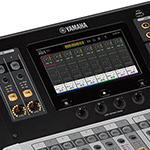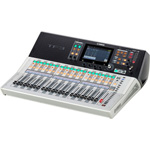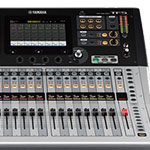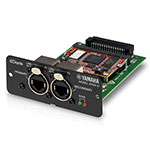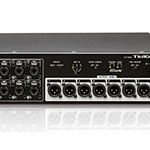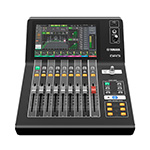Opening Times
- Mon - Sat
- 9.00am - 5.30pm
- Sundays
- Closed
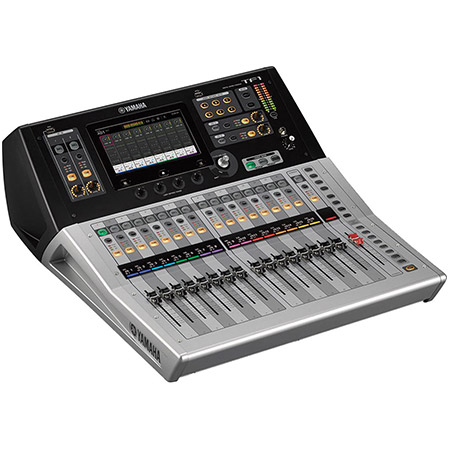
Yamaha Yamaha TF-1 Digital Mixing Desk - Refurbished
We do not have this model available as ex demo / refurb at the moment
Please feel free to call us so we can advise if we are expecting a shipment
New version is here - Click
Other Options
| info | specs | videos |
|---|
PLEASE NOTE: Our refurbished TF-1 model is in mint as new condition supplied with original box, software and full Yamaha 2 year warranty.
Yamaha has always made it a mission to stay in touch with the needs of sound engineers worldwide. The outcome is evident in the success of the recent CL and QL series digital mixing consoles, and the flagship RIVAGE PM10. The key to success has always been in supporting the user's creativity. Creativity is most effective when unrestricted, and now Yamaha has created a new digital mixing console that gives the user's intuition even freer rein. TouchFlow Operation introduced in the TF series consoles allows the user to respond to the music and artists on stage with unprecedented speed and freedom, taking live sound reinforcement to a new level of refinement. With the TouchFlow Operation interface optimized for touch panel control, experienced engineers as well as newcomers to the field will find it easier than ever to achieve the ideal mix. Recallable D-PRE preamplifiers support sound quality that will satisfy the most discerning professional ears, while advanced live recording features and seamless operation with high-performance I/O racks give these compact digital mixers capabilities that make them outstanding choices for a wide range of applications. Experience the intuitive control and creative freedom that a truly evolved digital console can provide.
TouchFlow Operation - Smooth, Natural Control Flow
Yamaha digital consoles have always been designed with input from leading engineers worldwide to ensure that the most efficient, intuitive operation is achieved. The highly regarded Selected Channel and Centralogic interfaces attest to the success of that approach. The TF series combines Yamaha know-how with new input from the field and the latest touch-screen technology to deliver an evolved experience in console operation. Smooth setup and operation, practical presets and scenes, refined design, and software applications that integrate seamlessly with the entire system: these elements comprise TouchFlow Operation, a new concept in console interfaces that offers unprecedented comfort and convenience in small consoles, for a wide range of users and applications.

In developing the TF series Yamaha engineers built from their existing base of acclaimed high-end mixer interfaces, adding intuitive control in an interface
optimized for the type of touch panel control that has become a familiar feature in a wide range of applications. Allowing most operations to be carried out via the touch panel alone, the innovative TF series interface will quickly become second nature to a broad spectrum of users. Whether you have experience with Yamaha digital consoles, work with other digital consoles, operate analog consoles, or have never operated a mixer before, TF consoles will lead you to the desired results quickly and effortlessly through a smooth, efficient workflow. The availability of physical controls surrounding the touch panel further enhances control versatility and precision.
Touch Operation for Intimate Control
Refined for the smoothest possible operation via touch-panel control, the TF user interface offers a smooth workflow that can be an advantage in any mixing situation. The display content has been specifically designed for easy, direct accessibility, with a layout that promotes the most natural, efficient mixing. Touch panel operation is as easy as shaping the sound with your fingertips.

Touch & Turn Knob Offers Extra Control Precision
When you need extra precision for a fine EQ or other adjustment, the physical Touch & Turn knob is always available right beside the touch panel. There are also four User Defined Knobs below the panel that can be assigned to control compressor threshold, EQ gain, or other parameters you need fast, direct access to while mixing. The knobs always affect the currently selected channel.
Traditional Overview and Selected Channel Interfaces
Like the CL series consoles, operation is based around Overview and Selected Channel windows. The overview display shows the parameters for eight channels at a time, while the Touch & Turn knob provides direct access to gain, 1-knob EQ, 1-knob COMP, gate threshold, effect send level, pan, and other parameters. Touch the highlighted parameter a second time to switch to the Selected Channel display when you need access to detailed parameters for finer control.

Effective gain, compressor, and EQ setup requires a considerable degree of skill and experience. Even veteran engineers need to spend time on these important basic settings. In addition to their intuitive user interfaces, TF consoles include a number of features that contribute to faster, smoother setup of these essential parameters.
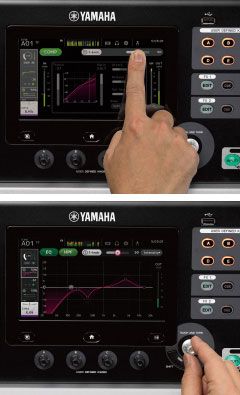
1-knob COMP & 1-knob EQ: One Knob to Dial In the Ideal Sound
An experienced engineer can do a lot with a compressor: bring a guitar to life, add punch to bass, tighten up a snare, and make vocals ride clearly on the mix. The 1-knob COMP can do all of this quickly and easily, without the need to juggle multiple parameters to achieve the desired effect. Originally introduced in Yamaha analog mixers, the 1-knob COMP quickly became a popular and valued feature. It has now been further refined in a digital version that adds new setup ease and efficiency to the TF consoles.
The same concept has been applied in a new 1-knob EQ feature that provides notably improved speed and smooth operation. 1-knob EQ has been painstakingly fine-tuned by Yamaha R&D staff in cooperation with distinguished sound engineers, to ensure that you can achieve outstanding results with minimum effort in the shortest possible time. A Vocal Mode makes it easier than ever to achieve a clear, well defined vocal sound, while an Intensity Mode offers 1-knob "intensity" control over EQ curves you either select from the presets or create from scratch.
But there's more: the 1-knob COMP and 1-knob EQ are provided on the output channels too, so you can quickly achieve overall output compression or EQ that ideally matches the room and audience size. The output 1-knob EQ has a Loudness Mode in place of the Vocal Mode, effectively increasing the sound pressure level while maintaining optimum sound as you rotate the knob.
Both the 1-knob COMP and 1-knob EQ provide quick access to the full compressor and EQ displays, so you can fine tune settings as required.
GainFinder Supports Precision Gain Setup
Gain is the first adjustment the input signal sees, and the way it is set up influences how subsequent parameters will affect the signal. Yamaha has developed a way to make fast, accurate setup of this important basic parameter easier than ever. The new GainFinder feature facilitates optimum gain setup for individual input signals so that ideal overall operation and signal quality is achieved.
The user only has to set channel gain so that the central green indicator in the level meter remains lit for the longest possible time. Of course the level meters also perform their traditional function, so standard gain setup procedure can be followed if preferred.
The familiar Yamaha scene memory that stores mix settings for instant recall when needed is included as always. There's also a range of channel presets that have been created in cooperation with leading microphone manufacturers and eminent sound engineers, providing starting points that take you a long way towards achieving great sound.
The channel presets cover parameters such as HA gain, EQ, dynamics, and much more, right down to details like channel name and color. Less time needs to be spent on basic setup so that more time is available for refining the mix and communicating with the performers.

QuickPro Presets Provide Instant Access to Pro Sound Setups
The Yamaha R&D team developed a selection of optimized QuickPro Presets for a wide variety of microphones and output equipment by working in collaboration with well-respected engineers and major manufacturers such as Audio-Technica, Sennheiser, Shure and Ultimate Ears.
With these practical presets even the novice engineer
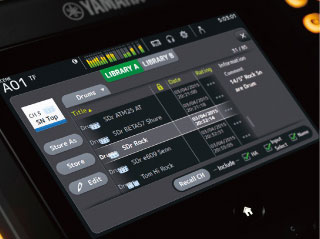 can get very close to the ideal sound, while experienced engineers will appreciate the significant time savings.
can get very close to the ideal sound, while experienced engineers will appreciate the significant time savings.
For input channels we prepared more than 100 presets that range from vocals to drum sets. All the presets were precisely tuned by using a wide range of actual microphones, instruments. For output channels we developed presets for a variety of speaker systems and in-ear monitors such as Ultimate Ears with several variations to match different environments and room sizes. All of these can be used as is when time is tight, but they are also great starting points for manual fine tuning. Setups created from the presets or from scratch can be saved as additional presets too. The 1-knob EQ and 1-knob COMP can be used with QuickPro Presets providing a super-streamlined way to tweak your sound. In addition to the onboard presets, new QuickPro Presets will be added to the Yamaha Pro Audio website, so be sure to check for updates.
Comment from Audio-Technica Corporation
"Each Audio-Technica microphone is painstakingly designed to give a truly accurate reproduction within the application it has been selected for. We strive to provide the best possible tools allowing the user to realise the expression of their work. Collaborating closely with the TF engineers on the instrument specific presets means that we can be sure our microphones deliver their best performance, while leaving the user free to focus on the creativity and character of the production."
Comment from Sennheiser
"The presets in the Yamaha TF series digital mixers provide users with an accurate indication of how to set the EQ for a wide variety of instrument/microphone combinations. These preset functions give the sound technician a solid basis to start from. All that is needed is to adapt the EQ-ing to the specific room and the instruments."
Comment from Shure
"We're thrilled to be offering QuickPro presets of our most popular SM, Beta, KSM and PG Alta microphones in the new TF mixer. When you combine Shure's 90 years of microphone experience with the versatile new TF digital mixer and exceptional Yamaha speakers, these presets allow engineers at any level of experience to leverage our combined technical expertise for quick, simple and effective sound checks and performances that sound amazing. Engineers can focus on mixing great quality audio instead of chasing problems. It's an incredibly powerful solution."
Comment from Ultimate Ears
"True technical innovations melt into the background and simply become part of life. Marvelous innovations make you wonder what you ever did before. And when you combine the collective industry knowledge of Yamaha, Shure, Sennheiser, Audio-Technica, and Ultimate Ears, art happens. Ultimate Ears is honored to share our outboard presets for in-ear monitors. We know that these combinations will help you take your performance to the next level."

Two Scene Memory Banks
The scene memory features banks A and B, each capable of holding up to 100 scenes.
That's a total of 200 scenes that can be set up and instantly recalled whenever needed.
A number of scenes are pre-programmed to give users a head start: scenes with the 1-knob COMP and 1-knob EQ controls engaged for the easiest possible operation, and scenes with the 1-knob features disabled for experienced engineers who might want to follow an established procedure. The banks are great for organizing different types of scenes: one for scenes categorized by music type, and the other by event type, for example.
The TF series hardware is packed with features that contribute to superior operability and convenience. Faders, knobs, and buttons with outstanding fit and feel work seamlessly with state-of-the-art display technology, including high-visibility channel name and color displays. The touch panel itself offers an ideal blend of comprehensive visual feedback and fast response.The physical layout of these components brings everything together in a system that offers surprisingly efficient workflow.
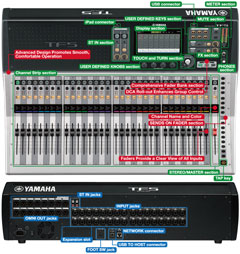
Panel Layout Maximizes Workflow Efficiency
Careful analysis of the workflows favored by a large number of engineers has led to a highly efficient panel layout. Rather than simply providing a long list of advanced features, the TF consoles present meaningful features in the most logical and accessible way through an overall design that maximizes visibility and operability.
Comprehensive Fader Bank section
Two INPUT banks and one OUTPUT bank are provided, and the GROUP bank can be selected by pressing both the INPUT bank buttons simultaneously. The GROUP bank allows the levels of multiple channels to be controlled from a single DCA fader. There's also a CUSTOM fader bank where you can assign any input, output, and DCA group to any fader.
DCA Roll-out Enhances Group Control
When the GROUP fader bank is selected, all faders other than DCA masters 1 through 8 function as Roll-out faders. Selecting one of the DCA groups instantly "rolls out" the input channels belonging to that group to the Roll-out faders. This useful function makes it easy to adjust the level and other parameters of individual channels while using the eight DCA faders for overall mixing.
Channel Name and Colour
A display panel located above each channel fader shows the assigned channel name or ID, the port name, and the current fader setting. Phantom power status as well as gate and comp operation can also be displayed. A color bar that shows the assigned channel color makes visual navigation a breeze, and prevents confusion when fader banks are changed or scenes are recalled.
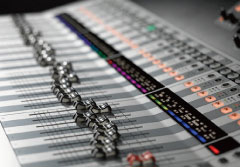
Faders Provide a Clear View of All Inputs
The TF5 has 33 motor faders, the TF3 has 25, and the TF1 has 17. All rear-panel inputs have individual faders so their status can be verified at a glance and they can be directly and immediately accessed for control.
SENDS ON FADER section
The SENDS ON FADER buttons instantly bring the specified AUX or FX bus levels up on the faders for easy verification and adjustment. When a SENDS ON FADER button is engaged the MASTER fader acts as the master for the corresponding bus, so AUX levels can be checked and controlled without having to switch fader banks.
Advanced Design Promotes Smooth, Comfortable Operation
The upper section of the panel is designed to double as a rest for an iPad, set list, score, memos, and/or other small items. The panel consists of three angled sections that give the operator maximum visibility and access.
Other Features for Efficient Workflow
- USER DEFINED KNOBS section: Frequently used parameters such as compressor threshold and EQ gain, for example, can be assigned for direct, instant access when needed.
- USER DEFINED KEYS section: Assign mixer settings that you use often to these six buttons for instant access, such as direct one-touch recall of specified scenes.
- MUTE section: Multiple inputs or effects can be muted with a single operation.
- FX section: A dedicated channel offers easy effect ON/OFF switching, cue monitor ON/OFF switching, level adjustment, and effect parameter editing.
- ST IN section: In addition to allowing digital playback from an iPad or iPhone or recording/playback with a USB device, you have fingertip control of BGM playback and other audio files.
*When using a USB storage device for recording, use a hard disk drive or other high-speed device. (USB memory drives are not guaranteed to function properly.)
Separate software applications that allow wireless mixing, personal monitor mixing, or offline setup of digital live mixing consoles have become fairly common.
The TF series goes a step further with three dedicated apps - TF Editor, TF StageMix, and MonitorMix - that feature user interfaces that seamlessly extend the console's own on any device.

TF Editor Facilitates Offline Editing Plus Showtime Control
The TF Editor application for Windows and Mac computers provides a complete interface for offline editing and setup of TF consoles, with scene and preset management capabilities plus convenient keyboard entry of channel names. In addition to being able to set up the console offline at any convenient location and time, the TF Editor can be used online at the same time as the TF StageMix and MonitorMix applications. A Windows 8 PC with a multi-touch screen can use the same gestures as on the console itself. And if using Wi-Fi, a PC can function as a convenient remote-mixing device. Up to three devices running TF Editor or StageMix can be connected at the same time.
TF StageMix for Wireless Mixing
TF StageMix is an iPad application that provides wireless control of TF series consoles, allowing remote mixing from audience seating, in front of floor monitors, or any other listening position. It can also be used at the console as an extension of the console's own interface. The TF StageMix interface is designed for similar operation and flow to the console display, making it easier than ever to refine the mix from any location.
Personal Monitoring with MonitorMix
The MonitorMix application for the TF Series allows individual wireless AUX mixing from up to 10 iPad, iPhone, iPod touch or Android devices simultaneously. Each performer can have convenient control over the AUX buses assigned to them, without having to deal with complex settings or parameters. They can also create personal Group settings for even easier adjustment; all levels on just one fader, for example. Since up to three devices running TF Editor or StageMix and up to 10 devices running MonitorMix can be connected at the same time, even large bands can have the personal control they need, reducing demands on the sound engineer.

Faithful reproduction of the on-stage sound is the foundation, then creativity can take over.
Yamaha's unswerving approach to live sound reinforcement is alive and well in the TF series.
The input stage of any console has a notable effect on its sonic character.
The TF consoles feature acclaimed D-PRE microphone preamplifiers that not only deliver outstanding quality, but are recallable as well. Circuitry and individual components have been reassessed and redesigned where necessary to achieve extraordinarily pure, natural sound. That solid sonic foundation is backed up by an updated selection of high-performance processors and effects. Input and output channel processors such as EQ, gates, and compressors are complemented by eight processors that provide a broad spectrum of creative capabilities.
Recallable D-PRE Microphone Preamplifiers
The TF series consoles feature new recallable versions of Yamaha's acclaimed D-PRE microphone preamplifier. The preamplifiers, or head amplifiers in any console play a significant role in defining the sound of the final mix, so Yamaha engineers spared no effort in developing and refining the D-PRE design to ensure that every nuance and subtlety of the original signal is effectively captured. The circuit is based on a discrete inverted Darlington pair configuration that achieves clean, precise amplification with consistently low noise and distortion at all signal levels. While some microphone preamps are built specifically to impart a unique character of their own, the D-PRE preamplifier has been painstakingly designed with a flat, wide frequency response that retains the tone and nuance of the original sound so that the essence of the performer's art is captured intact.
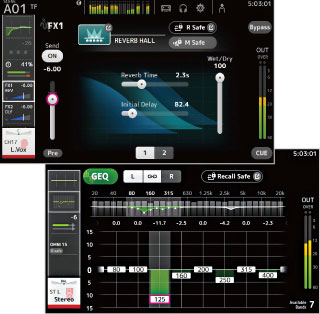
8 Powerful Processing/Effect Units and More...
In addition to channel processors, TF consoles feature eight powerful processing/effect units. All the units feature the same type of SPX processors that have become standards in recording and live sound applications, offering 19 programs ranging from reverb and delay, through modulation effects such as flanger and chorus, to multiband compression. With two units of global FX the panel EDIT key opens the effect parameter display where detailed parameters can be adjusted instantly. The remaining six Ins FX are available in the AUX 9/10~19/20 master channels for additional signal control ie. managing levels for in-ear monitoring, or controlling output delay for remotely located speakers using a delay. If more than two Global FX units are required, these Ins effects can be used as additional SEND/ RETURN effects by assigning them to the main stereo bus. The AUX 1~8 buses and main output channels include the same 4-band parametric EQ as provided on the input channels, plus 31-band Flex12 GEQ. Both types of EQ are invaluable for optimizing speaker response and eliminating feedback. These GEQ can also be assigned to the physical faders for more detailed fine tuning.
Revolutionary Dan Dugan Automatic Mixer Built In
Thanks to in-depth collaboration with Dan Dugan Sound Design, renowned Dan Dugan automatic microphone mixing with its advanced algorithms is built into the TF series consoles. The processor is abailable for input channel 1-8, you can accsess the setting screen easily from their channnel strips for automatically optimized microphone gain distribution. Gain control is smooth and natural, as though experienced human operators were doing the mix. The system also effectively reduces feedback and comb filter issues. For speech applications, especially non-scripted situations, this allows the operator to concentrate on details other than fader operation for consistently high-quality mixes.
Various mix to maultiple speaker systems -Matrix Out Channels with Delay-
Four matrix out channels with delay parameters that are ideally suited to setting up delay compensation for live sound speaker systems at large venues, installations where separate mixes are fed to a main hall and lobby, and many other situations that require some degree of delay compensation.
Additional Output Delay for Ins FX
TF V2.5 also includes a simple Output Delay that can be used as an Ins FX on the AUX 9/10 ~ AUX 19/20 buses to manage the timing of signals sent to speakers at different locations for improved intelligibility and clarity.
Live recording capability is becoming increasingly important in live sound systems. From simple 2-track recording using a USB storage device* to all-out multitrack recording with a computer based DAW (Digital Audio Workstation), the TF series is ready to roll. TF consoles come supplied with Steinberg's Nuendo Live Multitrack live recording software, providing an easy way to simultaneously record up to 34 tracks to a computer connected to the console via USB 2.0.
MP3 and WAV files can be played back from USB storage devices, and audio from an iPhone or iPad can be played back via a direct digital connection.
When playing back from a DAW, analog input or DAW input can be individually selected for each channel so that pre-recorded material can be mixed with live input for virtual sound checks or rehearsals.
Of course BGM and sound effects can be played back too.
*Please note - USB thumb drives are not supported by TF for recording purposes. Please refer to this link for compatible hard drives.

Nuendo Live multi-track live recording software is bundled
Steinberg's Nuendo Live multi-track live recording software is bundled with TF series digital mixing consoles. Nuendo Live multi-track recording software is ideal for use in live sound applications, from club gigs to concert halls and festivals. It offers simple operation that is an advantage in busy live sound situations, high reliability, and a comprehensive range of features that provide professional performance and efficiency. Not only multi-track recording, Nuendo Live offers a virtual sound check when the performers aren't available. Many users will benefit from the advanced multi-track recording and virtual sound check capabilities that this powerful combination of hardware and software provides.
The natural, musical sound that was a key element of the TF Series design policy is carried on without compromise in the Tio1608-D I/O Rack (details on following page). Mechanical construction, circuit board layout, power supply, grounding, and parts selection have all been executed with meticulous attention to detail and quality, and exhaustive performance and listening tests were carried out at each stage of development. For networking the same Dante protocol implemented in higher end Yamaha digital consoles is used for precise synchronization, low latency, low jitter, and high sample accuracy.
In addition to superior performance, a Tio1608-D stage box system can be set up in just three easy steps.

Tio1608-D I/O Rack
The Tio1608-D is a Dante equipped I/O rack with 16 microphone/line inputs and 8 line outputs. The Tio1608-D preamplifiers can be remotely controlled from a TF series console. Connection from an on-stage Tio1608-D to a TF console at the mixing position only requires a CAT5e LAN cable for high-quality low-latency audio transfer. No bulky, heavy multi-cables and connector boxes are required. What's more, basic patches are pre-programmed for fast, easy setup. Up to three Tio1608-D units can be connected simultaneously, providing a high-performance, high capacity stage box system with as many as 40 inputs and 24 outputs. The network connections can be daisy-chained when Tio1608-D units are used with a TF series console, eliminating the need for network switches.
NY64-D Audio Interface Card
The NY64-D is an I/O expansion card for TF series consoles that allows transmission and reception of up to 128 channels (64 in/64 out) of uncompressed 48 kHz 24 bit digital audio data via a Dante audio network.
Used in conjunction with the Tio1608-D I/O it becomes possible to create a versatile stage box system with up to 48 inputs and 24 outputs.
TF1: Rack Mountable with Optional RK5014
The RK5014 Rack Mount Kit can be used to mount the TF1 console in a standard 19-inch EIA equipment rack of the type commonly used in live sound, studio, and installed applications.
*14units are needed for the TF1 console alone. Considering the cable connections, 16units are recommended.

Dugan Automixer: Prevent feedback and unwanted pickup with multiple microphones
Dugan automixer can be applied to up to eight channels in the TF series, automatically raising the gain of microphone inputs that are active while lowering the gain of inactive microphone inputs, and adjusting each to create a consistent overall mix level. This eliminates the need for complex fader operation during presentations where multiple microphones are used, or at panel discussions where an even larger number of microphones may be required. Advanced Dugan automatic mixing algorithms also maintain a safe feedback margin, ensuring high quality, high clarity sound at all times.
Dugan Automixer 1
When nobody is speaking the input level at all microphones is low and the gain is equal. Rather than being muted, gain is distributed equally between all microphones.
Dugan Automixer 2
When one person is speaking the gain of that person's microphone is instantly increased to 0dB while the gain of the remaining microphones is lowered. The same occurs when any other one person is speaking.
Dugan Automixer 3
If two people speak simultaneously the gain distribution between the active microphones is adjusted to achieve consistent overall gain, while the gain of the remaining microphone is lowered.

Yamaha TF1 Outline
- Fader Configuration: 16 + 1 (Master)
- Mixing Capacity
- Input Channels: 40 (32 mono + 2 stereo + 2 return)
- Aux Buses: 20 (8 mono + 6 stereo)
- Stereo Buses: 1
- Sub Buses: 1
- Input channel functions: 8 DCA Groups
- I/O
- Inputs: 16 mic/line (XLR/TRS combo) + 2 stereo line (RCA pin)
- Outputs: 16 (XLR)
- Expansion slots: 1
- On-board processors
- DSP: 8 Effects + 10 GEQ
Yamaha TF1 General Specifications
- Sampling frequency rate
- Internal: 48 kHz
- Signal delay: Less than 2.6 ms, INPUT to OMNI OUT, Fs=48 kHz
- Fader: 100 mm motorized, Resolution = 10-bit, +10 dB to -138 dB, -0 dB all faders
- Total harmonic distortion: Less than 0.05% 20 Hz-20 kHz @+4 dBu into 600 Ω , INPUT to OMNI OUT, Input Gain=Min. (Measured with a -18 dB/octave filter@80 kHz)
- Frequency response: +0.5, -1.5 dB 20 Hz-20 kHz, refer to +4 dBu output @1kHz, INPUT to OMNI OUT
- Dynamic range: 110 dB typ., DA Converter, 107 dB typ., INPUT to OMNI OUT, Input Gain=Min.
- Hum & Noise level
- Equivalent input noise: -128 dBu typ., Input Gain=Max. (Measured with an A-Weight filter)
- Residual output noise: -85 dBu, ST master off (Measured with an A-Weight filter)
- Crosstalk: -100 dB (Measured with a -30 dB/octave filter@22 kHz), adjacent INPUT/OMNI OUT channels, Input Gain=Min.
- Power requirements: 100-240 V 50/60 Hz
- Power consumption: 100W
- Dimensions
- Width: 510 mm (20.1in)
- Height: 225 mm (8.9in)
- Depth: 599 mm (23.6in)
- Net weight: 13.5 kg (29.8lb)
- Accessories: Quick Guide, Power Cord, Nuendo Live
- Options: Rack-mount Kit RK5014, Expansion Card, Foot Switch (FC5)
- Others: Operating temperature range: 0-40C, Storage temperature range: -20-60C
Recording/ Playback
- PC/Mac (USB2.0): Recording 34 tracks, Playback 34 tracks
- USB Storage Device: Recording 2 tracks (USB hard drive/ SSD)*, Playback 2 tracks (USB hard drive/ SSD/ thumb drive)
*Please note - USB thumb drives are not supported by TF for recording purposes.
Additional specifications not found here can be found on the official Yamaha website

